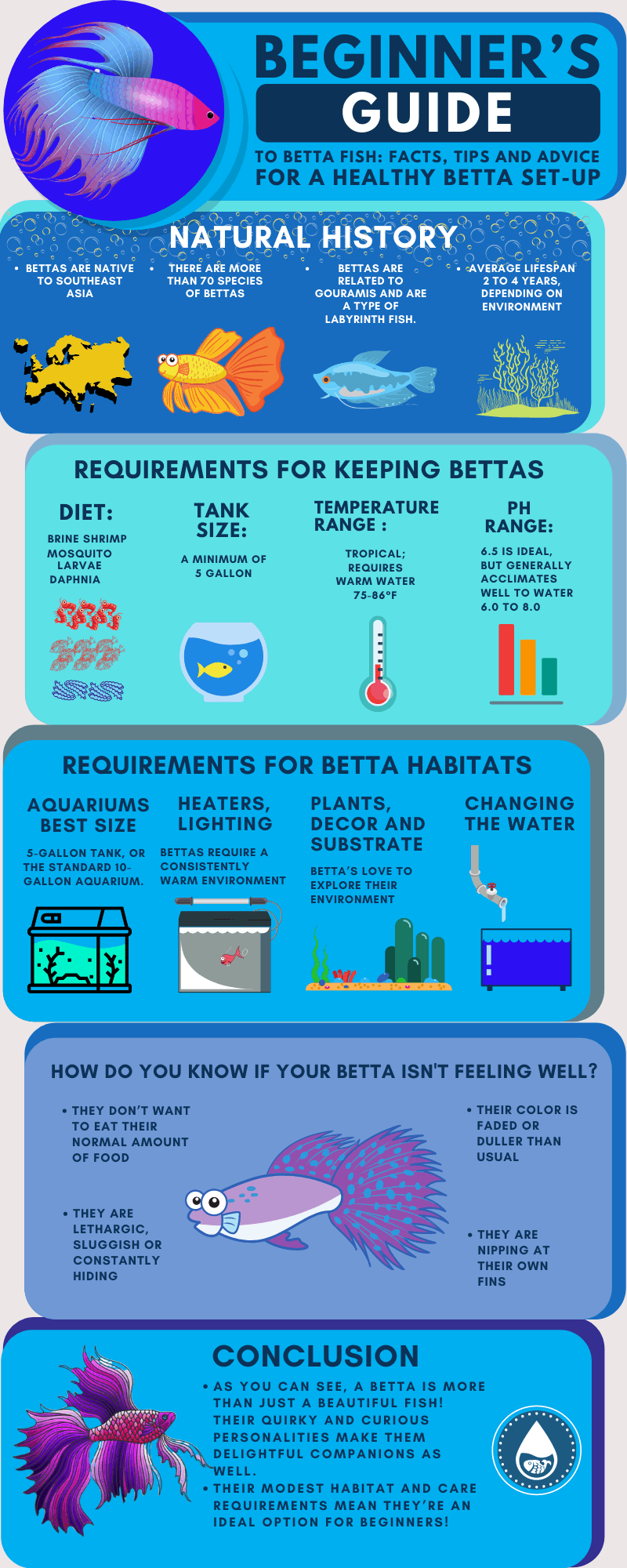It’s no surprise that betta fish (Betta splendens) are one of the most popular pets in the aquarium trade. These flashy fish have a delightful personality and come in a wide array of vivid colors with elaborate, decorative fins. They are an ideal fish for small tanks and thrive when kept on their own.
While bettas are often billed by pet stores as an easy and low-maintenance pet, you can’t keep your betta in a little cup of water and expect it to remain healthy. You’ll need the right aquarium set-up, feeding and maintenance schedule if you want your betta’s colors and personality to shine.
That said, bettas are an ideal species for beginning to intermediate fish keepers. They offer a few challenges for novice aquarists but are incredibly rewarding pets. Did you know you can even train your betta?
Read on to discover everything you need to know to keep your betta happy, healthy and radiant!
Complete Guide to Everything Betta
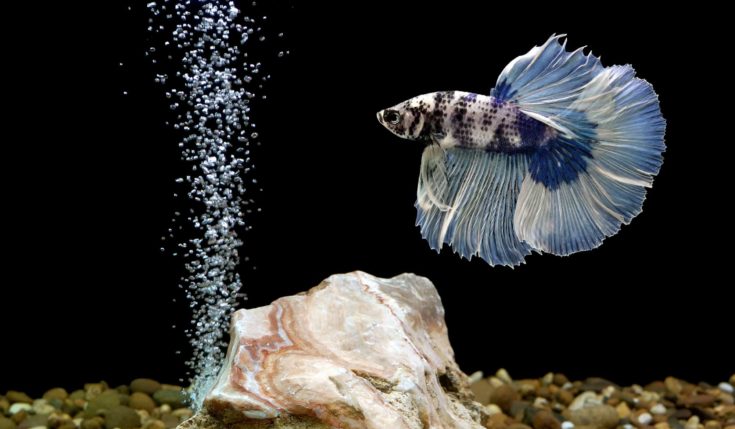
Before you dive into things, it helps to know a bit about the history, natural habitat and care requirements of the betta. That will help you avoid problems and prevent you from investing in the wrong set-up for your new pet.
Natural History—Where Are Betta Fish From?
Here’s a few quick facts about bettas and their natural habitat:
- Bettas are native to Southeast Asia, and wild varieties may be found in Thailand, Cambodia, Laos and Vietnam.
- You’ll find more than 70 species of bettas living in rivers, rice paddies, irrigation ditches and shallow puddles of water throughout the Mekong Delta.
- Bettas are related to gouramis and are a type of labyrinth fish, which means they have the ability to breath air from the surface above the water. This allows them to survive in low-oxygen environments and small amounts of water, for a time.
- While captive-bred and wild betta populations are overall considered stable, the IUCN Red List identifies several rarer species of bettas as critically endangered.
Why Are They Called Siamese Fighting Fish?
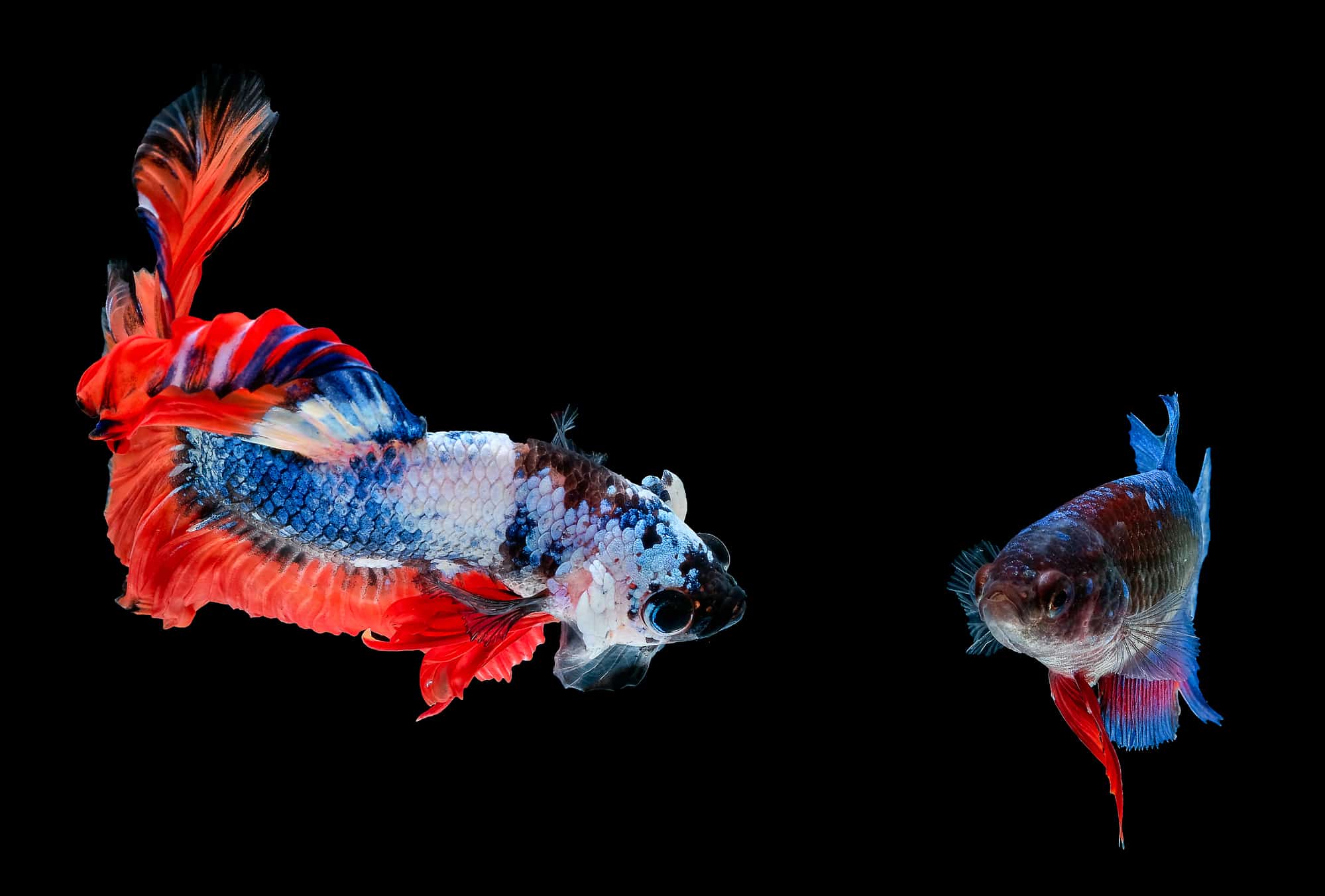
They are known as Siamese Fighting Fish because male fish are territorial and won’t tolerate the presence of another male nearby.
- In the wild, the pugnacious males will fight aggressively until one of them flees or is killed.
- Even in captivity, male bettas will flare their fins and try to attack another male if they can see one through the side of the tank. They will also act aggressively towards their own reflection in a mirror.
- Female bettas are not as aggressive and may be housed together in the same tank if there is enough room. But they still tend to pick on each other when stressed or bored, and may nip at other fish as well.
- Both male and female bettas are best housed in their own tanks, or with no more than a few small-finned fish about the same body size. Bettas don’t get lonely or interact with their tank mates unless they are under stress.
- When kept singly, bettas of both genders are usually fun, curious and rather mellow companions. They are responsive and willing to interact with their environment and the people around them.
It has long been a popular hobby in Thailand (formerly Siam) and Malaysia to breed bettas for their aggression and fighting ability. Although it is illegal in the US, betta-fighting is still a popular sport in parts of Asia. In 2019, Thailand officially listed the Siamese Fighting Fish as their National Aquatic Animal.
Appearance—Wild vs Domesticated Bettas
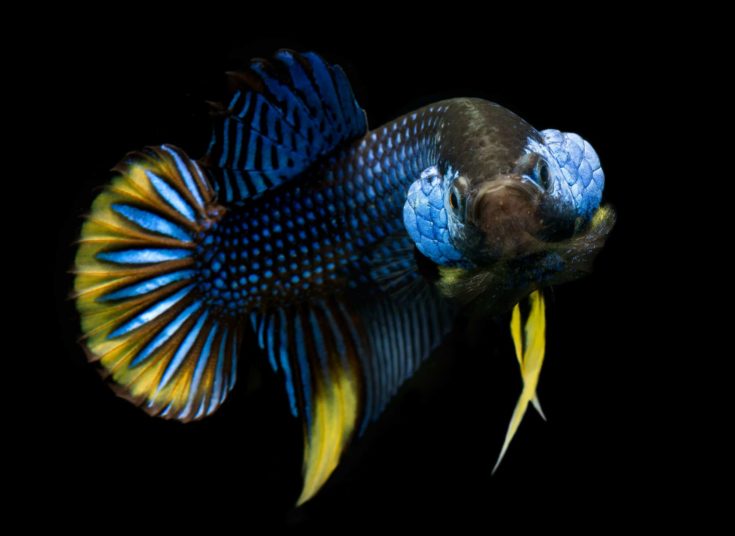
Wild species are quite drab compared to their captive-bred cousins. While you’ll see wild fish with splashes of color along their body or fins, it’s nothing like the vibrant hues you’ll find in pet bettas.
- Domesticated bettas may be any color of the rainbow, and often have opalescent or pearly highlights on their body and fins.
- Wild fish are usually grey or earth-toned, with plain stripes and perhaps a dash of green, orange or iridescent blue.
- The primary difference between wild bettas and the fancy-type you’ll see at an aquarium store are in the shape and length of the fish’s fins.
Bettas are a sexually dimorphic species of fish, which means the males and females have a distinctly different appearance. You can easily identify the gender of a betta at a quick glance.
Female bettas closely resemble their wild relatives in size and shape.
- They grow to a maximum size of about 2.5 inches when measured from their jaw to the base of their tail (known as standard length when measuring fish).
- Their total length is usually about 3 inches if you measure the tail as well as their body.
Male bettas, on the other hand, have long and strikingly flamboyant tail fins.
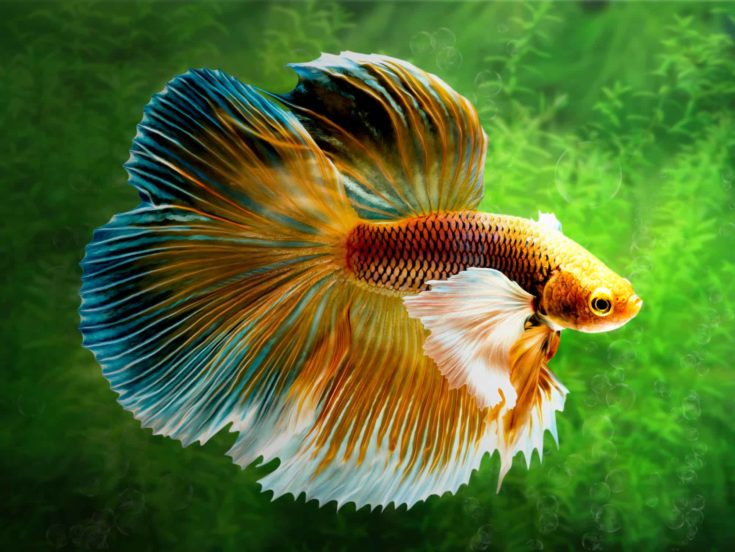
- Their pectoral, dorsal and ventral fins may also be elongated or ruffled, depending on the specific variety.
- While their bodies are the same length as a female’s, their elaborate tails can add up to two inches to their total length.
Why do some retail websites list their bettas as the same size, regardless of gender? It’s simply because they are using the standard length to measure their fish instead of the total length.
Gender
Male Betta
Appearance
- Thicker body than female
- Prominent beard (operculum) over gill cover
- Long tail, anal and dorsal fins. Ventral fins may be elaborate
- Color is usually deep and vibrant
Average Adult Body Length
2.5 inches
Average Adult Total Length
3.5 to 5.5 inches
Gender
Female Betta
Appearance
- Leaner body than male
- Beard is hidden under gill cover and difficult to see
- White spot (the ovipositor tube) noticeable at base of ventral fins
- Color is muted and dull compared to males
Average Adult Body Length
2.5 inches
Average Adult Total Length
3 inches
Are Pet Bettas Collected from the Wild?
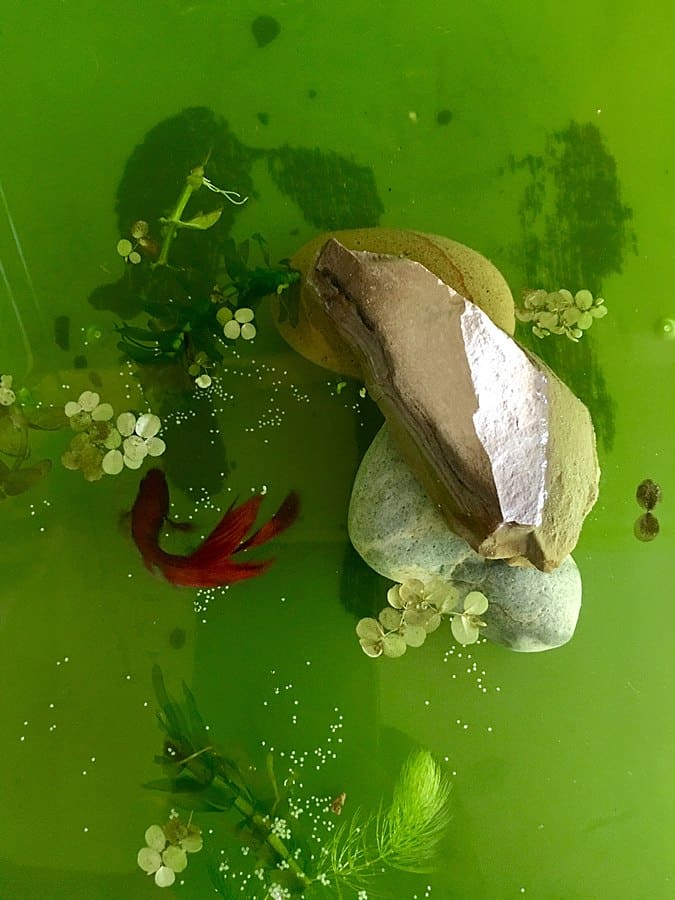
We’re not sure who first brought bettas to Europe, but hobbyists there have been selectively breeding bettas for their fancy colors and flowing tail fins since the late 1800s.
Most, if not all, of our domestic bettas are bred from these European lines and are many generations removed from their wild ancestors. You’re not hurting the environment or wild fish populations by getting a betta as a pet.
You can usually find a nice variety of male bettas at your local pet stores. When buying females and rarer varieties you might have better luck shopping at a local aquarium specialty store or online from a breeder.
Consider a Fancier Variety of Betta!
While the standard pet betta is a beautiful fish, if you really love those variegated tail fins or ruffled pectorals, consider getting a unique variety instead. These specially-bred fish have fancier fins and unique colors and patterns as well.
Some of the rare varieties include:
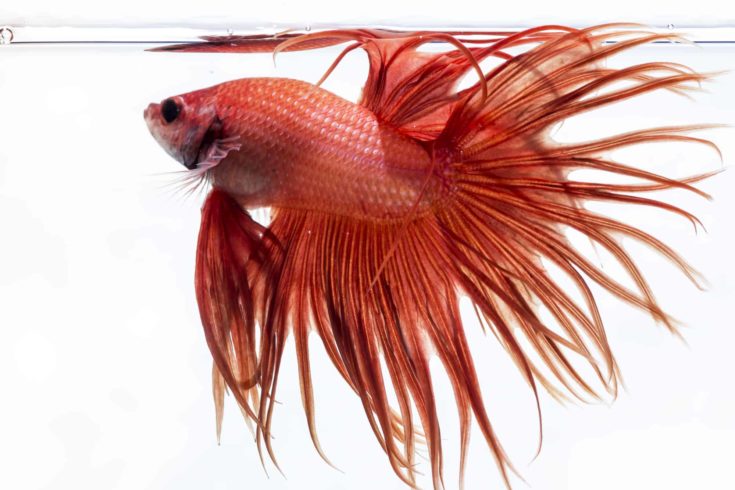
- Crowntail Betta
- Single, Double and Crossed-Ray varieties available
- Half-Moon Betta
- Double-Tailed Betta
- Combtail Betta
- Rosetail Betta
How Long do Bettas Live?
The lifespan of a betta varies widely depending on the conditions in which it is kept. If you provide a spacious habitat with plenty of decorations, and maintain it properly, your betta should easily live for 2 years. Some aquarists have kept bettas for up to 5 years!
Is it Easy to Breed Bettas?
It isn’t hard to breed bettas, but it does take a fair amount of equipment and close attention to water quality. Poor water conditions are the most common reason for a mating to fail.
It’s very easy to convince a male betta to build a bubble nest, and your male will likely build one on his own if he is happy and well maintained. But there’s more to breeding bettas than just tossing a male and female together.
Baby bettas, called fry, hatch from eggs laid by the female. During the mating dance, the male (and sometimes the female) take the fertilized eggs and place them in the bubble nest. The male protects and cares for the eggs until the fry hatch a few days later.
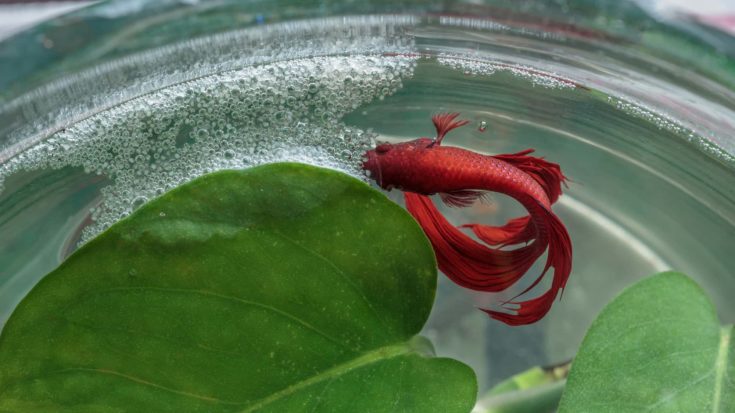
It usually only takes a few hours to a day for your fish to breed, and then you’ll need to remove the female from the tank. Your male betta will act very aggressively towards her once she’s laid her eggs. She might snack on the eggs, too.
Once your fry hatch, you’ll need to remove your male betta and put him back in his home tank. He might injure them accidentally, and some males even eat their young. It’s best for the fry to have the tank to themselves.
So if you want to breed bettas, you’ll need:
- Individual aquarium set-ups for each of your breeder fish
- Separate tank set-up suitable for mating and raising fry
- Eventually, you’ll also require several extra tanks so you can separate the fry as they mature
Breeding fish takes a lot of equipment, since each tank requires a heater, lid and some kind of filtration system. To raise healthy fry, you’ll need to use a fine sponge filter in their tank so the water circulates very gently. You’ll also need plenty of plants and other things for the fry to hide in.
Quick Facts and Requirements for Keeping Bettas
Common Name (species)
Betta, Siamese fighting fish (Betta splendens)
Family
Belontiidae
Origin
Southeast Asia
Diet
Carnivore; prefers live food like brine shrimp, mosquito larvae, tubifex worms and daphnia. Captive-bred fish will easily eat at commercial betta diets and frozen foods.
Care Level
Easy to Intermediate
Activity
Mellow and Curious
Temperament
Curious and mellow; nips at self and other fish when stressed or bored*See Compatibility
Tank Level
All; prefers the Top of the tank for feeding
Minimum Tank Size
We recommend a minimum of 5 gallons
Temperature Range
Tropical; requires warm water 75-86°F
Water Hardness
KH 0-25
pH Range
6.5 is ideal, but generally acclimates well to water 6.0 to 8.0
Filtration/Flow Rate
Prefers well filtered water with a low flow rate
Average Lifespan
2 to 4 years, depending on environment
Breeding
Egglayer; males create a bubble nest when ready to breed and protect the eggs until they hatch
OK, for Planted Tanks?
Yes, ideal for planted tanks
Compatibility with Tank Mates*
Best kept in a tank on their own. Males should not be housed together; females and individual males may be kept with other, similar-sized small-finned community fish. Avoid housing with semi-aggressive or nippy species.
Caring for Your Betta—Feeding, Habitat, Equipment and More
Now that you’ve gotten the full scoop on the history, behavior and natural habitat of the betta, it’s time to talk about their care. What kind of environment does your betta need to stay healthy and happy?
Feeding Behavior and Diet
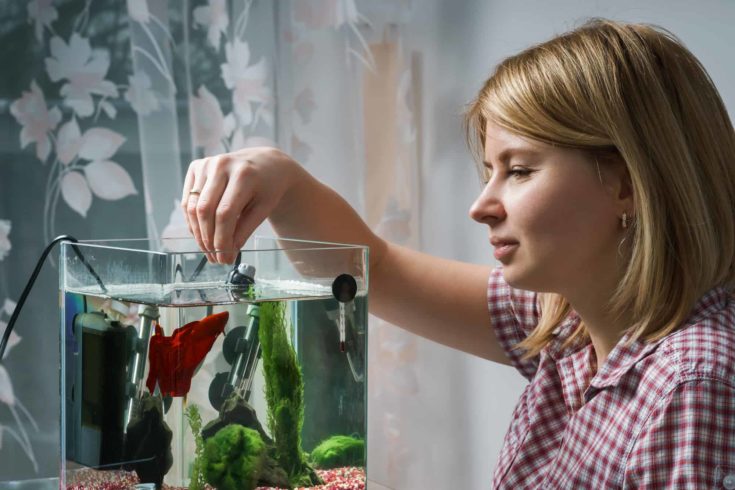
Bettas are carnivores and need a high-protein diet. In the wild, bettas survive by eating small insect eggs and larvae floating in the water around them.
Captive-bred fish are usually not very picky about their choice of food. They will readily eat fresh, frozen and commercial diets. They prefer to feed on floating foods rather than those that sink to the bottom of the tank.
Ideally, you would feed your betta a variety of live foods and supplement with a manufactured betta diet. But it isn’t always easy to get your hands on the live stuff unless you have a great aquarium shop nearby.
Your betta should do well if fed a high-quality, commercial betta diet. These are often called “betta bites” because the small, round pellets of floating food can be swallowed whole.
There are also flake foods specially for bettas. I’m not a fan of these diets. The flakes sink to the bottom of the tank and often don’t get consumed. They are messy and may force you to do more frequent water changes. Generic fish flakes are not suitable for bettas and should be avoided.
You may supplement a commercial diet with treats of fresh, freeze-dried or frozen foods such as:
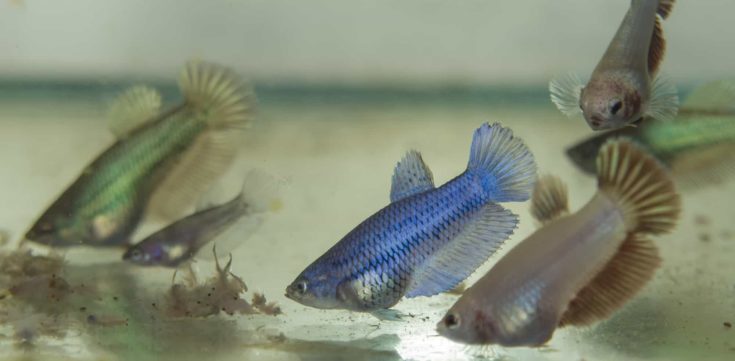
- Brine shrimp
- Mosquito larvae
- Tubifex worms
- Bloodworms
- Daphnia eggs
How Much and How Often Should You Feed Your Betta?
Bettas, like many species of fish, have no self-regulation when it comes to feeding. If food is available, they will continue to gorge until they hurt themselves. If something will fit in their mouth, they’ll try to eat it. You can gauge the size of your betta’s stomach by looking at their eyes.
A betta’s stomach is about the same size as their eyeball!
- Never offer your betta more food than they can consume in about 2 minutes.
- Overfeeding often leads to health problems like obesity, constipation and issues with their swim bladders.
If you’re feeding a commercial betta diet, ignore the directions on the packaging. Manufacturers typically overestimate the frequency of feeding and amount of food a fish needs for optimal health.
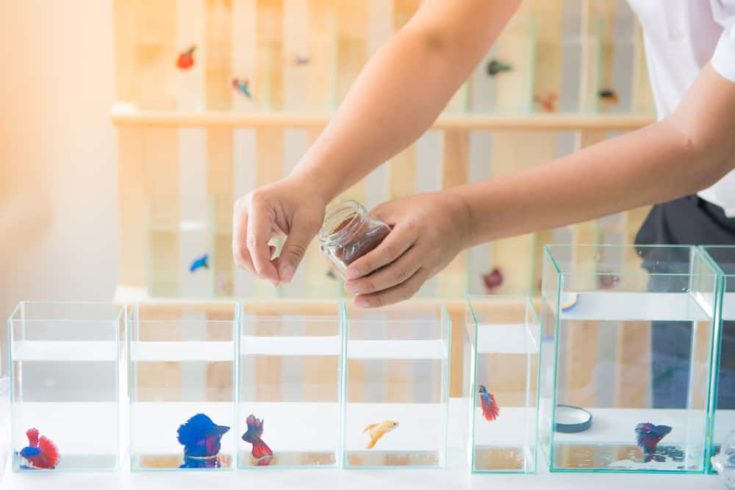
Instead, offer two pellets, flakes or treats and see how long it takes your betta to consume them. It’s best to soak the food in water for a few minutes before adding it to your tank. This way the food will rehydrate and expand before your betta swallows it.
If your betta gobbles the food up quickly, you can offer another piece. After 2 minutes, any remaining food should be skimmed out of the tank with a net and discarded.
I usually feed my adult bettas once a day, and alternate between feeding a commercial diet and a “treat” food. I like to fast my fish one day out of the week, to mimic their natural pattern of feast or famine. But you don’t have to follow this practice if it’s easier for you to feed your fish daily.
My weekly betta-feeding schedule looks something like this:
Day of the Week
First Day
Diet Offered
Commercial betta diet; pellets or flakes
Serving Size
2 to 4 rehydrated pellets or flakes
Day of the Week
Second Day
Diet Offered
Freeze-dried mosquito larvae
Serving Size
2 to 3 rehydrated larvae
Day of the Week
Third Day
Diet Offered
Commercial betta diet; pellets or flakes
Serving Size
2 to 4 rehydrated pellets or flakes
Day of the Week
Fourth Day
Diet Offered
Live brine shrimp or bloodworms
Serving Size
2 to 4, depending on size
Day of the Week
Fifth Day
Diet Offered
Commercial betta diet; pellets or flakes
Serving Size
2 to 4 rehydrated pellets or flakes
Day of the Week
Sixth Day
Diet Offered
Freeze-dried tubifex worms
Serving Size
2 to 5 rehydrated worms, depending on size
Day of the Week
Seventh Day
Diet Offered
Fast Day
Serving Size
No food offered
What Happens When You’re on Vacation?

It’s tempting to leave your betta with extra food if you’re heading out of town for a few days, but don’t give in to the impulse.
The excess food will just tempt your betta to overeat and potentially make them sick. The leftover food will spoil in the bottom of the tank and pollute the water, causing even more stress to your fish.
If you’re just going to be gone for a few days, your betta will be fine fasting. A betta can go up to 14 days without food, although I wouldn’t fast mine intentionally for more than 3 days. For longer trips, you might consider an automatic feeder, or hire a pet sitter to come over and feed your betta instead.
Requirements for Betta Habitats—Keep Fish Happy With the Right Set-Up!
What kind of equipment do you need to maintain your pet in comfort? It isn’t too difficult to set-up the perfect environment for your betta. These fish are easy to care for and don’t require a lot of expensive equipment.
Aquariums for Bettas—What’s the Best Size?
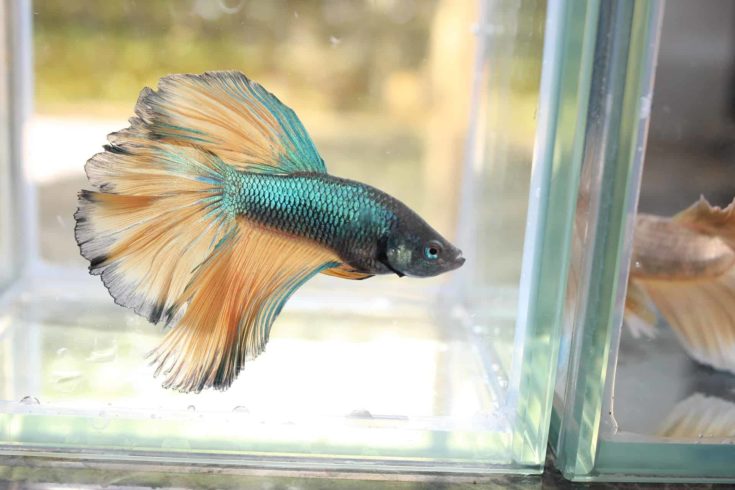
There are so many options when it comes to getting a betta tank. There are stacking cubes for housing multiple fish separately, or glass vases with decorative house plants growing up out of the water. But these tanks, cute as they are, are mostly unsuited for bettas.
Sure, pet stores often sell bettas in tiny cups of water. They like to emphasize their ability to breathe air and survive in murky puddles of water in the wild.
But this ignores one key fact: Surviving and thriving are not the same thing!
In the wild, a betta swimming in a small, shallow puddle will use it’s amazing ability to leap out of the water to find a better situation. They are not stuck living in that tiny space.
While a betta can survive in a small, ¼-gallon fish bowl temporarily, they quickly become bored and stressed in tight environments. Male and female bettas will bite at their own fins if they don’t have enough room to swim around. They lose color and appetite, and clearly seem miserable in these conditions.
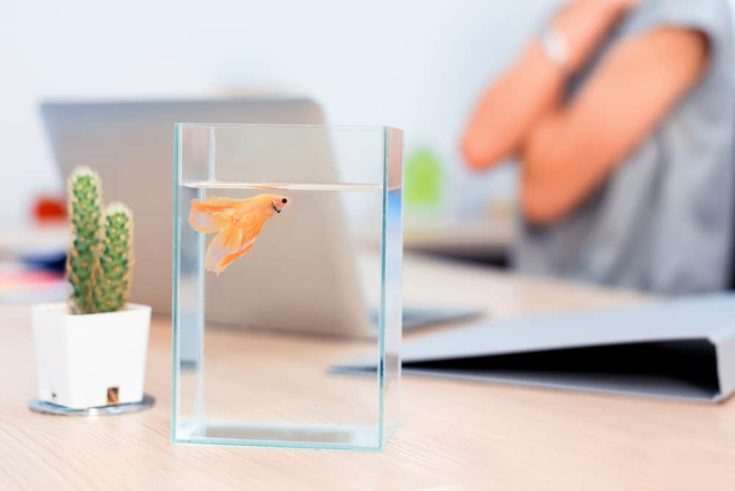
So what’s the smallest tank you can keep a betta in? If you do frequent (every other day) water changes, you can get by with a 1-gallon tank but we recommend against it. You won’t have room for decorations or plants, and your fish may grow bored, and they won’t live as long, but they should have some room to swim around.
A much better option would be a 5-gallon tank, and the best option, in my opinion, is the standard 10-gallon aquarium. Why do you need a tank this large for a fish that’s only 3 to 5.5 inches long?
Expert Tip:
If you really want your Betta Fish to thrive, give him lots of space, a few small unobtrusive tank mates like; shrimp or gang of cories, lots of plants, and feed him a meaty treat every week.
It’s really that simple: A 10-gallon tank with live plants, a few buddies, and good food.
Jack Dempsey, Owner of tropicalfishcareguides.com
It is actually easier to care for a bigger tank than a smaller one. You won’t have to change the water as frequently, and bigger tanks maintain a more stable temperature and water chemistry. When things go wrong in a tiny tank, they go wrong fast!
It’s also easy to find heaters, lights and filtration systems for these standard-sized tanks. If you go with a small or customized set-up you might not have any off-the-shelf options.
A bigger tank allows more room for you fish to swim, and for adding plants and decorations. Your betta will love having things to hide behind and explore!
Water Quality and Filtration Systems
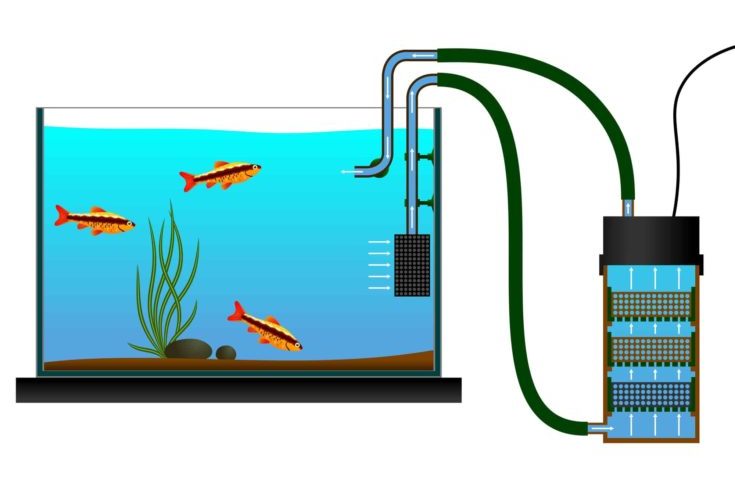
Bettas are a fairly hardy species and tolerate a pretty broad range of conditions. As I’ve mentioned, a betta can survive in muddy or murky water for a while in the wild, but a stagnant tank is another story.
Aquarium filtration systems do two things: They oxygenate and circulate water around your aquarium, and they filter out debris. Some filtration systems also use a substrate like carbon to remove impurities from the water as well.
You don’t need a filtration system for a betta tank. Bettas don’t require high levels of oxygen in their water, since they can directly breath air on the surface. They don’t like a lot of water circulation and actually prefer calm water, especially at the top of their tank. But they don’t like filthy water, either.
An unfiltered tank usually requires a partial water change every few days, or debris build-up on the bottom and your fish starts to suffer. Keeping a betta in a dirty tank will decrease their lifespan and increase their stress level. They may lose color and develop fin rot or other illnesses.
If you’re going with a standard 5 or 10-gallon tank, you should be able to pick-up an inexpensive, low-flow undergravel or hanging filter that will work well for your betta. A simple set-up with a replaceable carbon cartridge is the ideal type of filter for a betta tank.
Water Hardness, pH and Acidity
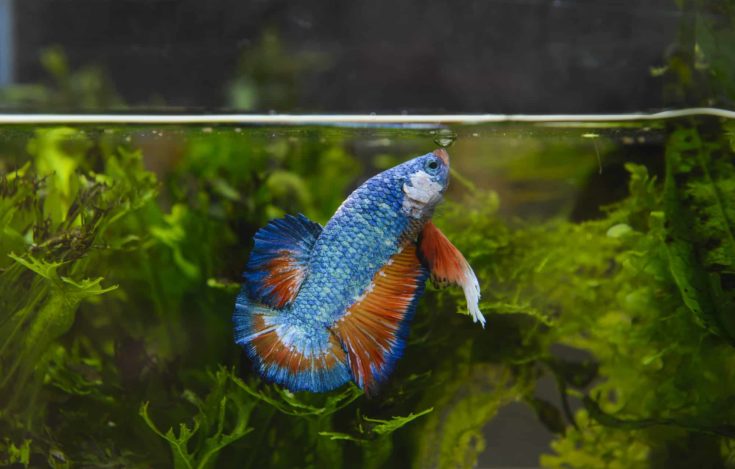
Bettas are not particularly sensitive to water hardness, and may thrive in a variety of conditions once acclimated. Unless you have extremely hard water, I wouldn’t worry about the level of mineralization in your tap water. Bettas do fine when the carbonate hardness (KH) is between 0 and 25.
Bettas do prefer slightly acidic water, and their ideal water pH is 6.5.
Your fish will acclimate to the local water conditions, however, so unless your fish is stressed it’s likely you won’t need to worry about the pH. It never hurts to have some test strips available in case of a problem, though.
Heaters, Lighting and Lids/Hoods
Bettas are tropical fish and require a consistently warm environment if they are to remain healthy. They do well when their water temperature stays stable and between 75-86°F. If your aquarium’s temperature is too low, or fluctuates a lot, your betta may not survive.
When I worked at an aquarium shop back in my college days, I often had customers bring in their drab, listless bettas for me to look over. I would usually discover they were keeping their betta in a fish bowl without a heater, or were adding in cool water when doing water changes.
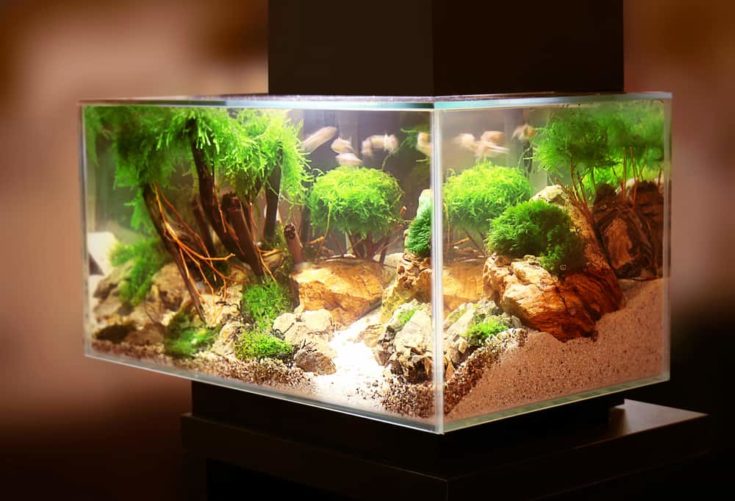
- Unless the residence stays at a consistent 79°F, year-round, then you definitely need a heater to regulate the temperature of your tank. Bettas are simply not a good option for a fish bowl!
- When adding water to your aquarium, it should be the same temperature as the water already inside (within a degree or two).
Bettas get very stressed when their water drops below 75°F, or suddenly shifts temperature more than a couple of degrees. Their activity level drops and they often refuse to eat. They are likely to get sick or develop an infection as well.
In terms of lighting, if your betta tank is in a dark corner of your home, then a small aquarium light may help your fish stand out and make your aquarium more attractive. Bettas prefer a natural cycle of light and darkness, so if your room is quite bright you might not need a light at all.
You will definitely need a lid or hood on your tank, however!
Bettas are great at jumping out of aquariums. It might be a legacy from their puddle-jumping ancestors, but they’ve been known to leap several feet away from their tanks, even when their owners were present. Keep your tank covered to keep your betta safe.
Plants, Decor and Substrate
If you get a bigger aquarium, you’ll have more room for adding decorations without cramping your fish’s style. Betta’s love to explore their environment and hide among the plants, sticks and rocks.
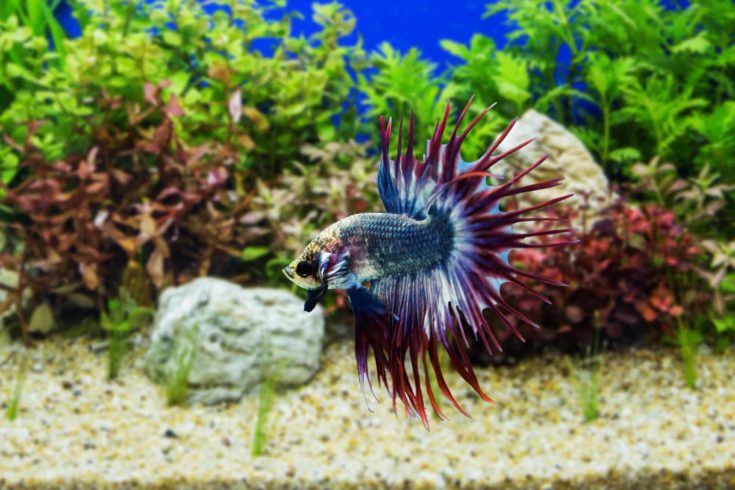
You can use live plants in your aquarium if it has a light or is in a brightly-lit room. If you opt for live plants, consider using a plant-friendly substrate with an undergravel filter. The filter will draw nutrients down through the substrate to the root of the plants.
Bettas enjoy playing with plastic plants as well. One male of mine loves to pull up his plastic plant and move it around his tank. It’s endlessly entertaining! You may also add some aquarium rocks, branches or other decorations to keep things interesting.
How to Maintain Your Betta’s Habitat
It’s hard to generalize about aquarium maintenance routines, because everything depends on the conditions in your betta tank.
How Often Should You Change the Water?
The smaller the tank, the more often you need to change the water. A densely planted tank with many resident fish will require more frequent water changes than a tank with no live decorations and a single fish.
If you have a filtration system in your betta tank, you may only need to do a small water change every couple of weeks, or even monthly. It’s hard to give you any hard-and-fast rules to follow because it just depends on your set up.
How Much Water Should You Change?
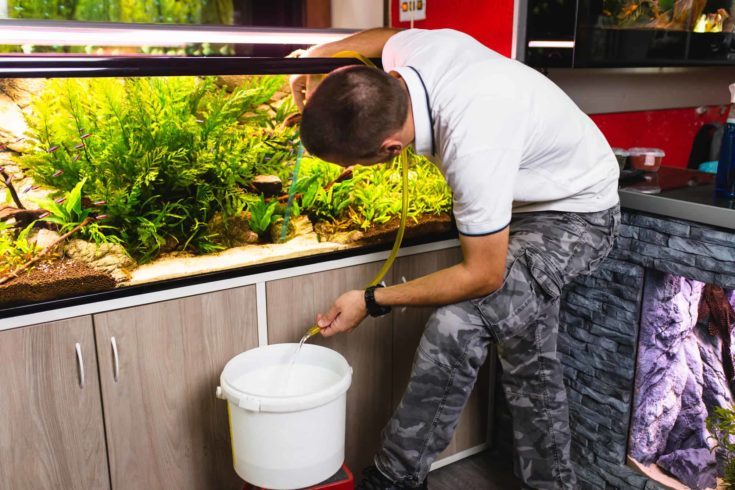
Aquarists usually talk about water changes in percentages, and it’s no different for a betta tank. There’s no need to be precise or measure the water when cleaning your tank; just note where your tank’s 50% or half-full line is and use it as a guide.
A routine water change is when you remove and replace about 10% to 25% of the water in the aquarium.
Leaving most of the water behind prevents you from stripping the good bacteria from the tank. It also maintains the tank’s balance in terms of water chemistry. Bettas don’t like it when their environment shifts suddenly. It’s better to gradually change the conditions in your tank rather than altering them all at once.
If your tank is really small, or very dirty, you may need to do a larger water change to quickly restore your betta’s comfort and reduce their stress. If your betta has tank mates, you’ll also need to change the water more often:
In a new aquarium, you can change up to 30%, or about ⅓ of the water, every 24 hours.
Once your tank is mature, around 3 to 6 months, you can safely replace up to 50% of the water at a time if you must, but smaller, more frequent water changes are still better and less stressful for the community.
Here’s a typical water changing schedule, showing how the ideal frequency and amounts can vary for a single betta depending on your tank’s capacity and filtration:
Approximate Tank Size
5-Gallon
With a Filtration System
10-25% water change
Weekly change ideal
No Filtration
25-30% water change
Once or twice a week
Approximate Tank Size
8-Gallon
With a Filtration System
10-25% water change
As needed or twice a month
No Filtration
25-30% water change
Weekly
Approximate Tank Size
10-Gallon
With a Filtration System
10-25% water change
As needed or once a month
No Filtration
25-30% water change
Every week to twice a month
How Do You Know if Your Betta is Healthy?
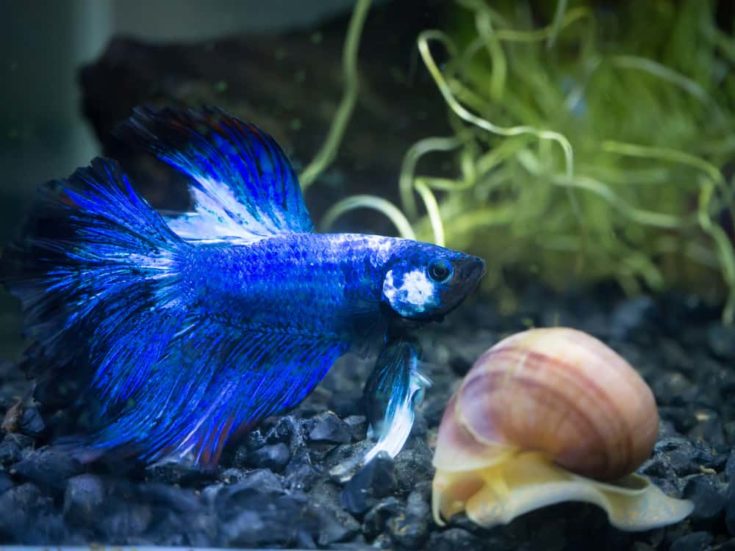
A healthy betta should be active, curious about its environment and have a good appetite. They will react when you approach their tank, and a male may even flare their fins at you. Their color will be deeper and more vivid than a fish under stress.
You can tell your betta is stressed and isn’t feeling well if:
- They don’t want to eat their normal amount of food, or refuse to eat for several days
- They are lethargic, sluggish or constantly hiding
- Their color is faded or duller than usual
- They are nipping at their own fins
The first thing to check is the temperature of your tank. If the water is under 75°F, that’s likely the reason your fish is unhappy. Try boosting the temperature to 80°F and see if the problem resolves.
Sometimes, however, your fish gets more seriously ill. Bettas are prone to several common aquarium diseases and disorders like inflamed gills, bulging eyes receding fins. It can be tricky for a novice fish keeper to sort out what’s going on without professional help.
If you notice any of the following symptoms, you should take your betta into a fish store or to a specialty veterinarian for diagnosis and treatment.
Symptom
White spots or cottony white patches along fins and/or body
Likely Problem(s)
Poor water quality, stress, contagion from sick tank mate
Possible Diagnosis
Columnaris, Ich/Ick
Possible Diagnosis
Yes
Symptom
Bulging eyes
Likely Problem(s)
Extended period in poor quality water, tuberculosis
Possible Diagnosis
Popeye
Usually Treatable?
Yes
Symptom
Swollen body; resembles a pine cone
Likely Problem(s)
Virus, bacterial or fungal infection
Possible Diagnosis
Dropsy
Usually Treatable?
Yes
Symptom
Rusty-colored spots or specks; rubbing body and fins along aquarium decor
Likely Problem(s)
Stress, low water temperature, poor water quality
Possible Diagnosis
Velvet Disease
Possible Diagnosis
Yes
Symptom
Unable to swim or dive normally; floating on side
Likely Problem(s)
Obesity, over feeding, bacterial infection, genetics
Possible Diagnosis
Swim Bladder Disorder
Possible Diagnosis
Yes, but it’s easier to prevent than treat and not all fish fully recover
Symptom
Growing bump or lump
Likely Problem(s)
Varies widely
Possible Diagnosis
Tumor/Cancer
Usually Treatable?
Depends on diagnosis. Tumors are usually fatal
Symptom
Edges of fins are black or red, ulcerated or receding
Likely Problem(s)
Poor water quality, low water temperature
Possible Diagnosis
Fin and Tail Rot
Usually Treatable?
Yes
Common Myths and FAQs About Bettas

Q: Since wild bettas live in mud puddles, can I keep my fish in a small bowl or vase instead of investing in an aquarium?
A: Small tanks of water under 5-gallons are less-than-ideal for bettas, and keeping your fish in tight quarters may increase their chance of illness and diminish their lifespan. No, you shouldn’t keep a betta in a fish bowl or similar-sized vessel without a heater.
Q: Is it better to get a male or female betta?
A: Both genders make great pets, and have similar personalities. Male bettas are more visibly impressive, with their bright colors and showy fins. Females are not quite as showy, are less aggressive and tend to do better in community tanks with other fish.
Q: Can I play with my betta?
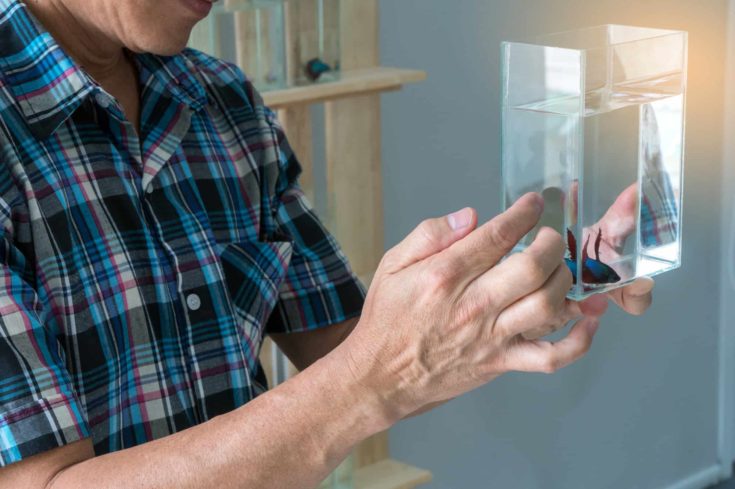
A: Sure you can! Your fish will naturally learn to respond to you when you feed it. Over time, they may follow your finger along the side of their tank, or go to the top when you tap on the lid. They are very trainable! Play around with it, and see what tricks you can teach your betta.
Q: If my male betta flares his fins when he sees me, does it mean he doesn’t like me?
A: Male bettas are aggressive and territorial, and typically flare their fins when they spot someone approaching their tank. But they usually learn to recognize that people mean food, and quiet down once you’ve fed them. If your betta is constantly flaring his fins at you it could be a sign of stress.
Q: Do individual bettas have unique personalities?
A: Within limits, yes. Some bettas are a bit lazy, while others are slightly hyperactive. I’ve already mentioned my male betta who likes to rearrange the plastic plants in his tank. As you get to know your fish, you’ll learn which traits they have in common with other bettas and which are their own, unique quirks!
Step-by-Step Guide to Setting Up Your Betta Tank
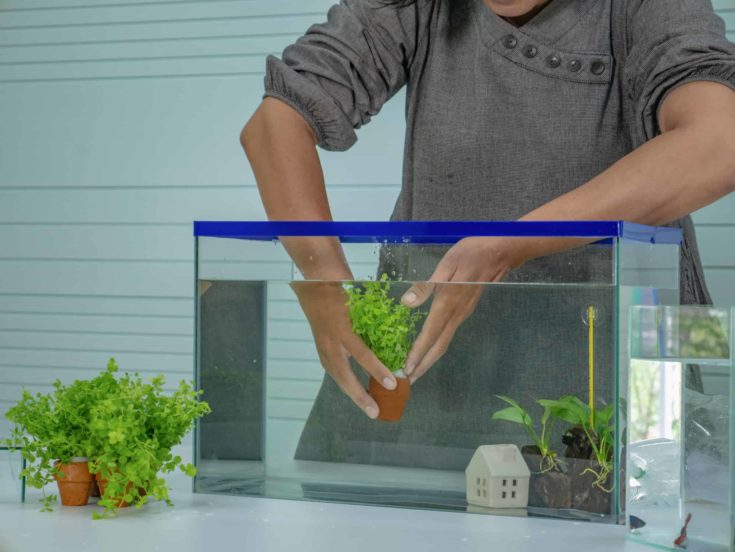
It isn’t hard to set up a tank for your new pet, but it’s best to get everything ready a few days before you plan on shopping for fish. You can find a complete list of everything you need for your betta tank below.
Setting your tank up prior to getting a fish gives your aquarium time to come up to temperature, allows the substrate to settle and helps the water chemistry achieve a natural balance.
First, rinse your tank and substrate and then add the gravel to your tank. Fill your tank with water, leaving a couple of inches free at the top. Add your filter, plants and decorations.
Set your aquarium heater and submerge it in your tank. Once submerged, you can attach it to the side and plug it in. Be careful with your heater. Heaters can and will explode if they’re out of water while they’re turned on or hot!
Turn on your filter and allow your tank to cycle for a day. If the water is still murky, do a 30% water change and give it another day. Check that your heater maintains the desired temperature and adjust if needed.
Once the water stays clear, top off your tank, leaving an inch of space for your betta to breathe. Use a water conditioner to remove any chlorine/chloramine in the tap water. Cover your tank. You’re ready to add your betta!
Recommendations for Your Betta Tank
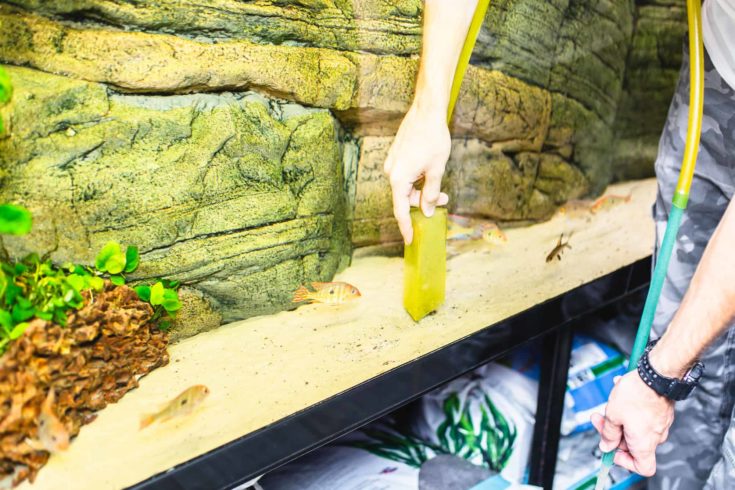
Here’s a list of some products that are helpful to have on hand to care for your betta.
To change your aquarium’s water and maintain a healthy environment , you’ll require:
- An aquarium siphon or vacuum hose
- Water conditioner to remove chlorine/chloramine
- Stress Coat Water Conditioner
- A new bucket you only use for your aquarium and fish keeping
- Rubbermaid Heavy Duty 10-quart Bucket
For the day-to-day needs of your betta, consider these products:
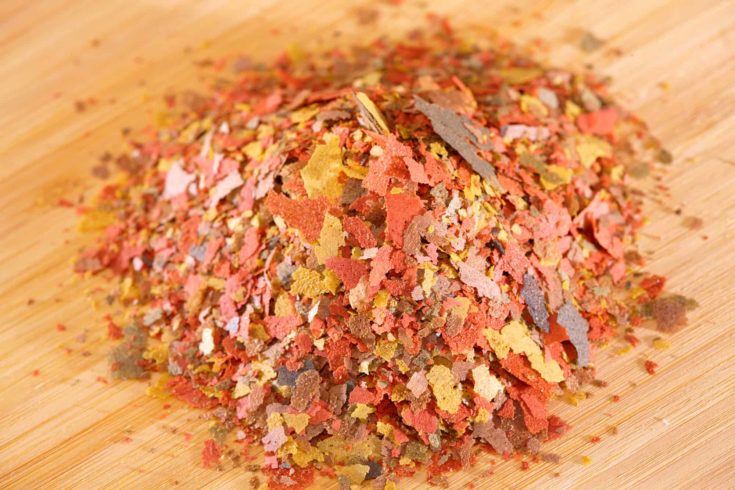
- Floating Fish Food
- Tetra Floating Betta Pellets
- Treats
- Tetra Freeze Dried Bloodworms
- Hikari Freeze Dried Daphnia
- Water Testing Strips
- API 5-in-1 Test Strips
- Books about Aquariums and Bettas
- The Betta Bible: The Art and Science of Keeping Bettas
Conclusion
As you can see, a betta is more than just a beautiful fish! Their quirky and curious personalities make them delightful companions as well. Their modest habitat and care requirements mean they’re an ideal option for beginners, and you won’t break the bank setting up your tank, either.
Hopefully, these tips and recommendations will help you keep your betta happy and healthy for years to come. We’d love to hear about your pet betta and aquarium set-up in the comments!
